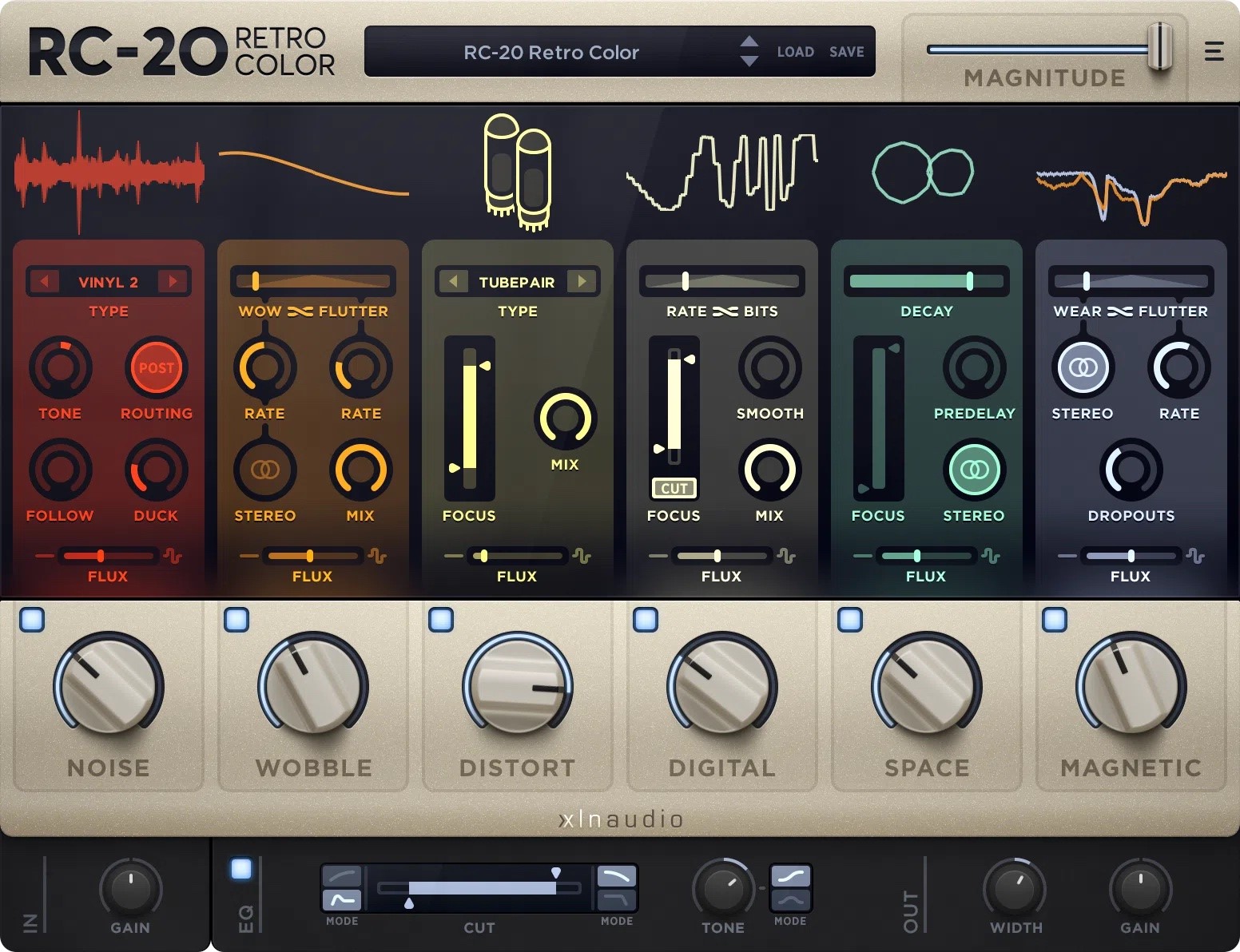RC-20 Retro Color (available here: RC-20 at Plugin Boutique) is an affordable and versatile production tool that every producer and engineer should have at their disposal. According to XLN, RC-20 should be on everything, including the master. And I have to say that after using this liberally over the past 6 months I must agree.

Use the 6 settings of Noise, Wobble, Distort, Digital, Space and Magnetic individually or use them all together to create one of a kind effects! You can set the magnitude dial of the overall plugin to adjust the wet/dry balance. What’s more, each individual setting comes with its own magnitude knob too.
Noise Generator
No doubt the go to choice to give your tracks some warmth. Get the tone, flux and ducking just right or choose from one of the several presets to dial in the sound and era you are looking for! Just be careful if you use this effect on the master channel and plan to export stems. You’ll find the effect stacking when the stems are recombined.
Wobble
This is by far the most fun, grooviest and creative way to give your track that special lilt! If you’re feeling trippy this is your choice. In fact, the RC-20 plugin has arguably the best sounding wobble effect of the lofi plugins on the market. What makes it even better is how customizable the settings are. You can dial in the rate for both wobble and flutter, each of which has very different characteristics. As with all of the six effects in the RC-20 vst, you also have control over ‘Flux’, which adds some special variations over time.
Distort
Give your track a little bit of edge or a full on crunch with this setting. A handy focus filter to mess up specific frequencies is a really nice touch for your track, stereo mix or master.
Digital
This gives you the ability to recreate that 90s free download sound. Of course you’ll also have the opportunity to ease off the harshness with the smooth dial and using the EQ focus feature. Additionally, being able to find the right balance between bits and rate is a useful setting on this component.
Space
Just as you’d expect, find your own universe within the RC-20 Retro Color’s space setting. With options for decay, pre-delay and stereo you can tap in to your own unique tastes while again finding a dial to focus the effect on a certain EQ.
Magnetic
For me, the dropout feature is unquestionably the cream of the crop to emulate wear and tear. In addition, it does a good job at mimicking the volume loss that comes with tape playback and recordings. Exploring the balance between wear and flutter is a great way to make the mojo work!
Presets
Feeling a little uninspired? The built in presets for the RC-20 vst are numerous and will get you on the path of deciding where to turn next. With presets like VHS, No More Boring Pads, and Crush Bass Square Maker, you won’t ever have a bland mix again. You can also find independent preset packs for sale on the web for even more inspiration.
Master Section
The RC-20 Retro Color plugin is topped off with a Master Section at the bottom of the plugin. Here you’ll find controls for Gain In, Gain Out and EQ. The In Gain is just what it sounds like while the EQ is relatively simple and allows you to make frequency changes within the plugin. Moreover, the EQ cut acts very nicely as a filter to give your sound that lofi feel. The out gain section gives you a handy width option going all the way from mono to stereo. The RC-20 Retro Color plugin is definitely a solid choice for the master chain in your lofi tracks!
Overall, I am a big fan of this and other XLN products. Indeed I highly recommend you give the RC-20 a spin with a 10 day free trial from their website. This will give you the chance to see if it is a good fit for your needs. If you’re looking for a good RC-20 price, remember that this plugin is often on sale e.g. at Plugin Boutique here: RC-20 on sale at Plugin Boutique. Happy creating!
If you’d like join in the discussion of our favorite low cost plugins, head over to our page here: Favorite Plugins – Free or Cheap?
Article updated February 17, 2023.
Article written by Mercer Lincoln.